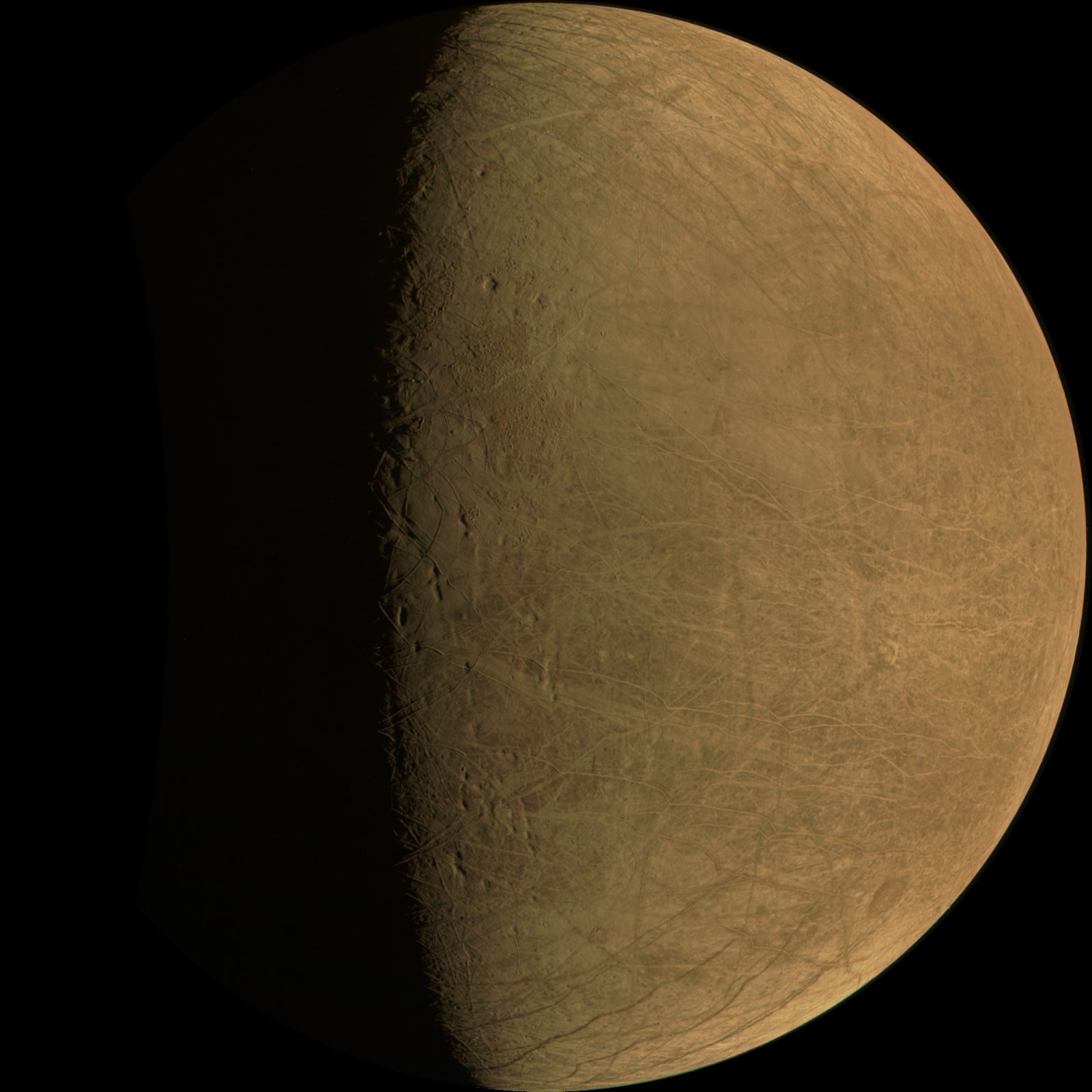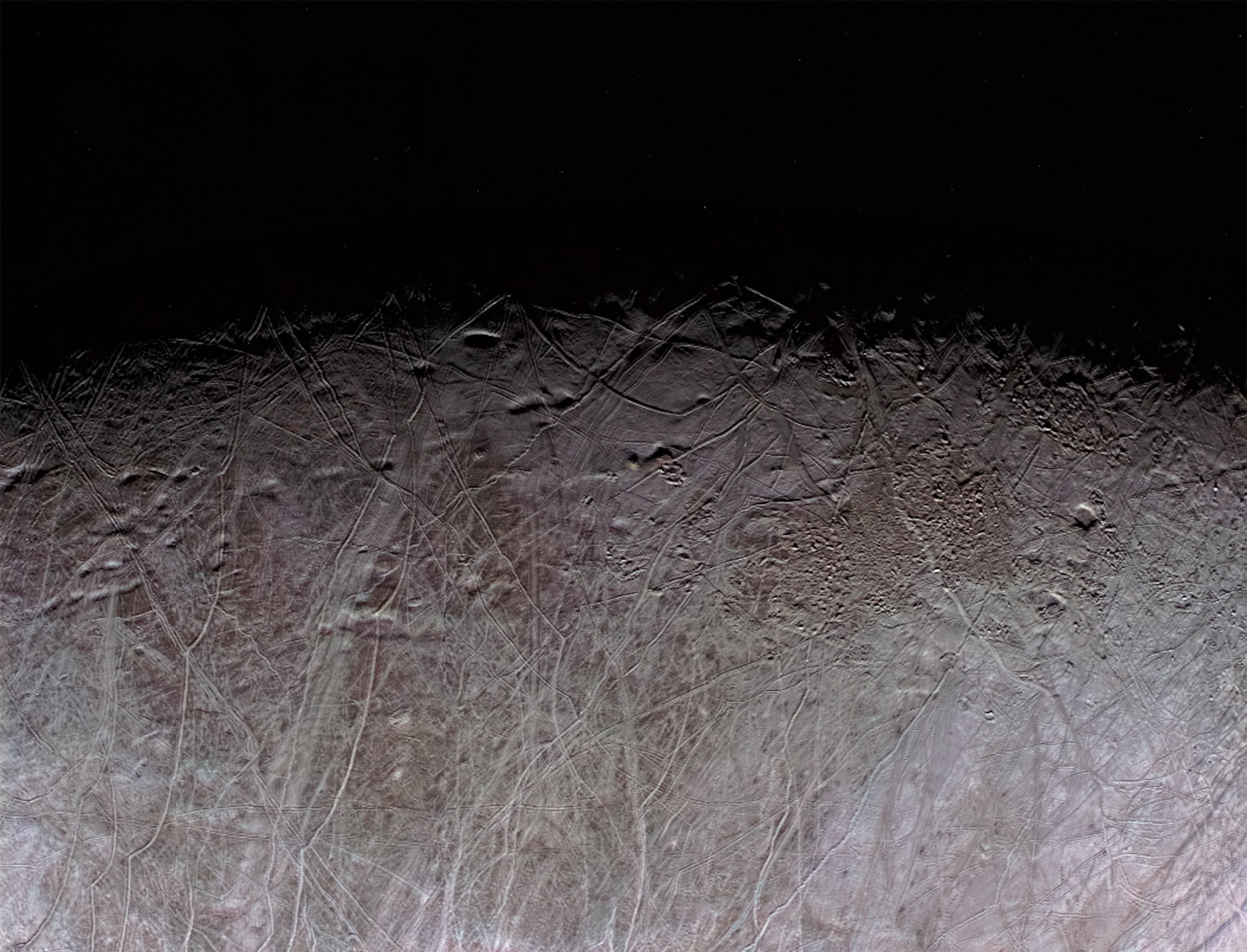The last week of September was a big deal for Jupiter. On September 26 the planet made its closest approach to Earth since 1963, delighting sky watchers around the globe. Then, on September 29, NASA’s Juno probe swung past Jupiter’s icy moon Europa—the closest approach to that natural satellite by any probe since 2000.
The flyby produced wonderfully detailed images of the frosty surface of Jupiter’s fourth-largest moon. And in addition to the images, Juno collected a trove of data that scientists will pore over in the months ahead to look for signs of watery plumes that might periodically erupt from an enormous briny ocean concealed beneath the crust. But in many ways, this flyby was just a teaser for upcoming missions—especially Europa Clipper, which is scheduled to launch in 2024 for a series of close-up orbital encounters with the icy moon to search for signs of habitability and perhaps even life itself.
The Juno probe’s encounter with Europa was speedy, and brief: The spacecraft flew by Europa at 23 kilometers per second, rapidly rotating the entire time, so it had to perfectly time its photographs as it passed. The resulting images—four of them in all—offer a detailed portrait of the distant world’s jumbled, chaotic surface, which is crisscrossed by jagged fractures and pocked with craterlike natural depressions—both likely products of the moon’s distinctly unearthly geologic activity.
This flyby is particularly thrilling because Juno was never meant to study Europa, let alone approach it so closely; the probe was designed to research Jupiter itself. Juno launched in 2011 and has been swinging around Jupiter’s neighborhood since 2016, collecting data on the planet’s clouds, weather, atmospheric properties and overall composition—in large part to better illuminate how the gas giant was formed. After several years of focusing the spacecraft’s investigations almost exclusively on Jupiter, NASA officials gave Juno a new lease on life, extending the mission to study some of the planet’s moons. “Last year we flew by Ganymede,” says Scott Bolton, principal investigator of the Juno mission. This past September “we [flew] by Europa. Next year we’ll go by Io.”
Jupiter has a grand total of 80 known satellites, but Europa’s vast ocean—thought to be more voluminous than Earth’s—makes the moon one of the most fascinating targets of research in the entire solar system. That fascination, Bolton says, comes from a perspective that’s “a little bit egotistical.”
“Oceans are important here,” he says. “So if we find any, maybe they’re important to life all the time.” Of course, it might turn out that life can emerge without an ocean—or even a single drop of water. But if we’ve found a potential liquid ocean just a couple of planets away, that certainly seems like a good place to start looking, Bolton suggests.
“Europa is one of the most promising worlds in our search for habitability and life,” says Lucas Paganini, program scientist of the Juno mission. “So these missions and their detailed studies are key to shortening the gap between Europa being just a promising habitable world and having the data needed to confirm its habitability.”

Still, in spite of the enthusiasm around Europa, there have only been a few flybys of the icy moon. The dark, cold depths of the outer solar system take years to reach and are a challenging environment for any spacecraft—but those venturing into the vicinity of Europa must also contend with the belt of harsh radiation that envelops the moon, produced by charged particles trapped in Jupiter’s powerful gravitational field. Besides Juno, which swung past Europa at a distance of 352 km, the only other probe to get close to the moon was NASA’s Galileo—and that was more than two decades ago. Galileo swung within 351 km of Europa in 2000 and, before that, flew by at a record-setting 200 km in 1997.
Because these flybys have been so infrequent, available data on Europa are sparse. Astronomers can and do routinely observe the moon remotely, but getting up close and personal has undeniable perks. For example, it was the Galileo flybys that supplied the best available evidence of Europa harboring a global liquid ocean. The probe found that the moon distorts Jupiter’s surrounding magnetic field in a telltale way that is indicative of some electrically conductive fluid lurking beneath the surface. “The most likely material to create this magnetic signature,” Paganini says, “is a global ocean of salty water.”
Could Juno’s flyby of Europa lead to similarly groundbreaking findings about Jupiter’s moon? For now, it’s too early to say; the data are still being analyzed. Juno has nine different research instruments, and as the spacecraft flew past Europa, they collected data on the moon’s magnetic field, gravitational field and almost nonexistent “atmosphere” of dilute gas.
Juno is also equipped with a tool called a “microwave radiometer.” “We literally invented it for Juno,” Bolton says. “It’s designed to be able to see below the cloud tops of Jupiter and into the deep atmosphere, but when you point it in an icy body, it sees into the ice at different depths.” Unless the ice is extremely “pure and clean,” Bolton says, this tool probably can’t peer deep enough to reveal a global ocean, but it should be able to detect pockets of liquid water closer to the surface. Plus, information on the structure of Europa’s ice shell is useful in itself. Analyzing Juno’s new data could take weeks or months, Bolton suggests, and will also yield more precise constraints on the moon’s radiation environment and orbital trajectory.
When the results are in, Juno’s Europa flyby should help scientists prepare for future missions that will focus on icy moons instead of planets. One such mission is the European Space Agency’s Jupiter Icy Moons Explorer, or JUICE. It is scheduled to launch in 2023 and to reach Jupiter in 2031. Once there, JUICE will study three moons: Europa, Ganymede and Callisto. It will be followed by an even more Europa-centric mission: NASA’s Europa Clipper, which is scheduled to launch in 2024 and to arrive at its destination in 2030—faster than JUICE, thanks to a powerful rocket and a more direct trajectory. Once it reaches the moon, Europa Clipper will perform at least 49 close flybys—some swooping within 50 km of the surface.
Naturally, many members of the Europa Clipper team were excited to see the first close-up photographs of Europa in 22 years. “I quickly grabbed the images and started playing around with them and trying to figure out where they were on the surface,” says Cynthia Phillips, a staff scientist at the Europa Clipper mission. “And I grabbed my Europa globe—which, fortunately, I had right with me—so I could start identifying surface features based on that.”
Phillips was particularly impressed by images of Europa that include a day-night boundary, or “terminator,” because the longer shadows there make topographic features easier to see. “There’s ridges, and there’s troughs, and there’s pits—you know, just all sorts of things going on there,” she says. Any changes in these features from Galileo’s previous flybys would indicate continued tectonic activity on Europa’s surface, Phillips says, helping to illuminate the nature and evolution of the moon’s geology over time.
Phillips compares the new images of Europa to seeing an old friend. “They have a new haircut. They’re a couple years older. But they’re still the same,” she says.

These new images aren’t just a fascination to the Europa Clipper team, though. They also offer tangible benefits as the team plans out its upcoming mission.
The first clear benefit is an updated map of the Jovian moon. “We’ll combine this new data with the Galileo and Voyager data and produce a new global base map of Europa,” says Alfred McEwen, deputy principal investigator of Europa Clipper’s imaging system. “That’s what we’ll use to target [Europa Clipper’s] images, initially—but we’ll quickly acquire much better data from Clipper itself. But early on, yeah, [Juno’s images] will make a difference.”
Depending on what is found in these images, Juno’s data may also help the Europa Clipper team find noteworthy areas to focus on during its flybys. As a key example, “I think everyone is really going to be staring at these pictures looking for plumes,” Phillips says. Plumes of water shooting from Europa, which have been tentatively detected in archival Galileo data, as well as through telescopic observations, would suggest a shortcut to accessing the moon’s watery subsurface that future spacecraft could exploit. Such plumes are postulated to cyclically occur, likely as a result of Jupiter’s periodic gravitational squeezing as the moon orbits around the planet.
If, against considerable odds, Juno’s images or other data do reveal hints of a plume somewhere on Europa, Europa Clipper could go study that area and—if timing and positioning allow—even fly through a geyserlike eruption in order to collect samples of Europa’s water. That sounds pretty far-out, Phillips says—until one recalls that the Cassini spacecraft flawlessly performed a similar stunt at Enceladus, a Saturnian moon that harbors subsurface reservoirs and erupting plumes as well. A sample of Europa’s water would allow researchers to look for organic compounds—or possibly even microbial life itself.
Bolton notes that Juno’s main goal was to analyze Jupiter and help us better understand the origin of planets. But now, by flying past Europa, the probe may ultimately help illuminate a different origin: the origin of life. “These, together, are some of the most fundamental questions that you can contemplate, both philosophically and cosmologically,” he says.
